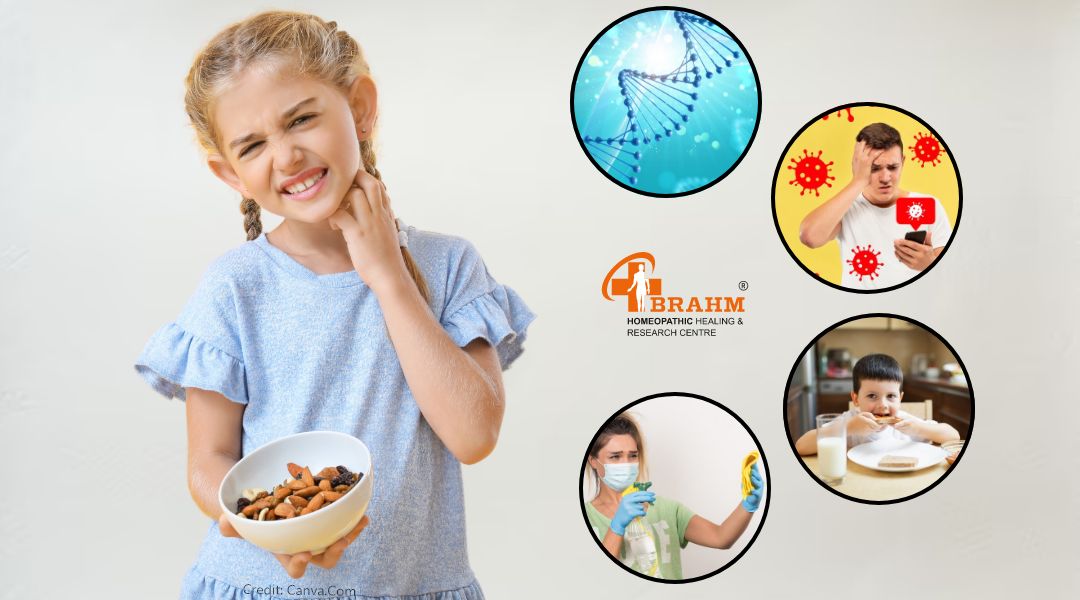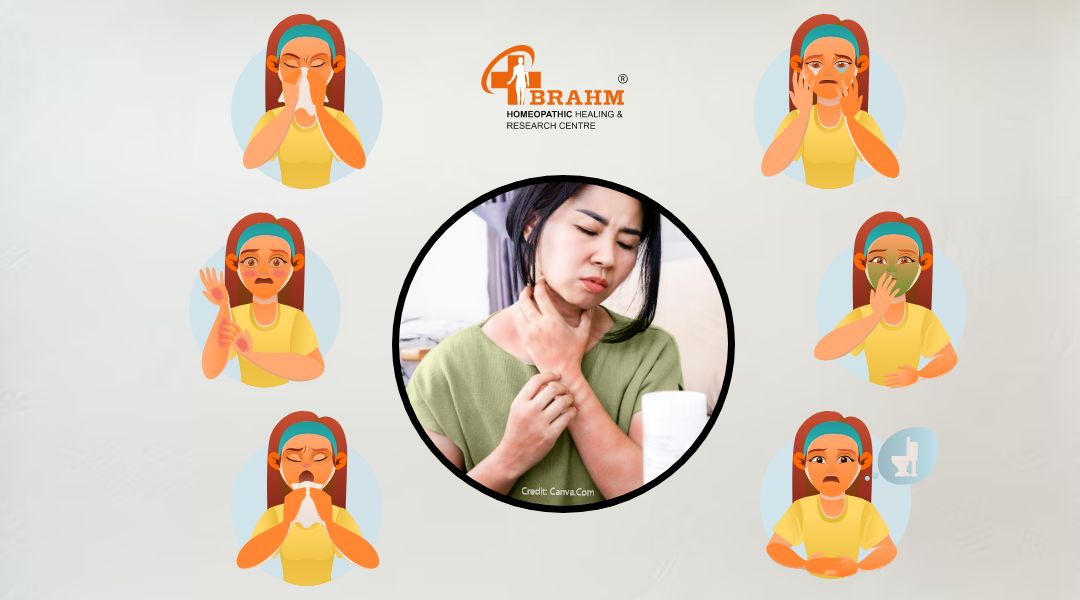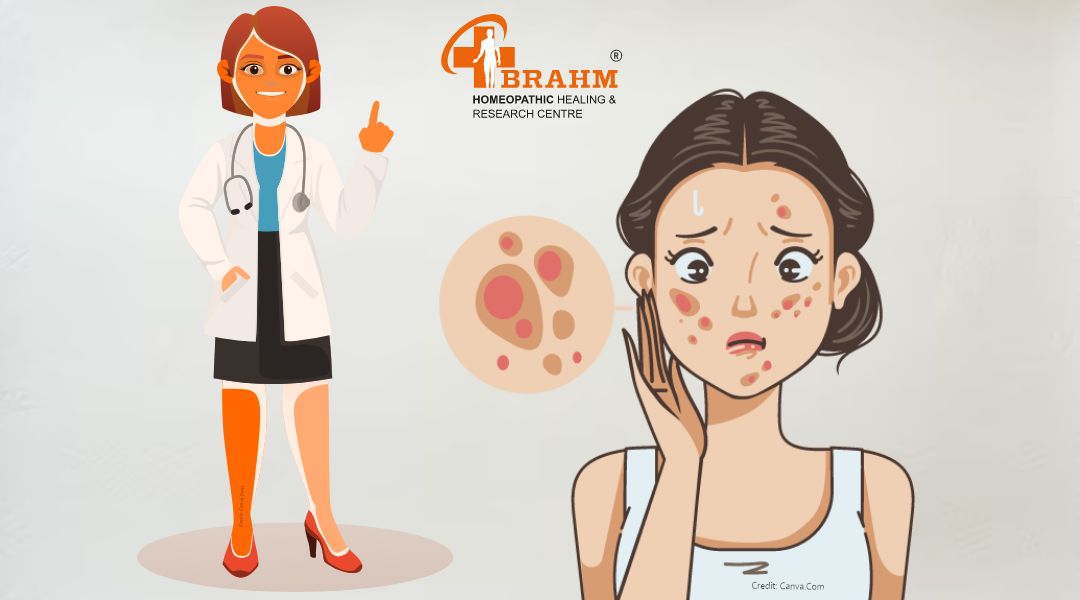
Food Allergy test and treatment in hindi | Food Allergy Testing and Diagnosis | food allergy ka ilaj homeopathy me
What is Food Allergy?
Food allergies are immune system reactions that certain foods can cause, leading to symptoms like hives, itching, and breathing difficulties. Common allergens include peanuts, tree nuts, milk, eggs, wheat, soy, fish, and shellfish. People with food allergies should read ingredient labels, communicate their allergies to staff, and carry emergency medication in case of accidental exposure.
Causes of Food Allergy?

Food Allergies: Genetic and Environmental Factors
• Genetics: A family history of allergies increases the likelihood of developing food allergies.
• Immune System Dysfunction: In individuals with food allergies, the immune system mistakenly identifies certain proteins as harmful invaders, triggering an allergic response.
• Early Exposure to Allergenic Foods: Introducing allergenic foods too early or too late into an infant's diet may increase the risk of developing food allergies.
• Environmental Factors: Pollution, diet, and lifestyle changes may contribute to the development of food allergies.
• Hygiene Hypothesis: Reduced exposure to germs and infectious agents in early childhood may lead to increased risk of allergies and autoimmune diseases.
• Other Factors: The composition of the gut microbiota, the integrity of the gastrointestinal barrier, and the role of specific immune cells may also influence the development of food allergies.
Features of Food Allergy?

Food Allergies: Manifestations and Features
• Immediate Symptoms: Symptoms include hives, itching, swelling, nasal congestion, sneezing, coughing, wheezing, difficulty breathing, abdominal pain, nausea, vomiting, diarrhea, and dizziness.
• Skin Reactions: Common in food allergies, include hives, eczema, and generalized itching.
• Respiratory Symptoms: Symptoms range from mild to severe, including nasal congestion, sneezing, coughing, wheezing, shortness of breath, and difficulty breathing.
• Gastrointestinal Symptoms: Symptoms include abdominal pain, cramps, nausea, vomiting, diarrhea, and bloating, common in infants and young children.
• Anaphylaxis: A severe, life-threatening allergic reaction requiring immediate medical attention, involving difficulty breathing, sudden blood pressure drop, dizziness, loss of consciousness, and cardiac arrest.
• Delayed Symptoms: Reactions may have delayed onset, making it difficult to identify the culprit food.
• Cross-Reactivity: Some individuals may experience cross-reactivity, where their immune system reacts to proteins in similar foods.
• Psychosocial Impact: Food allergies can significantly affect daily activities, social interactions, dietary choices, and emotional well-being.
Diagnosis of Food Allergy?

Food Allergy Diagnosis Process
• Medical History: Details about symptoms, timing, duration, suspected trigger foods, and family history of allergies.
• Physical Examination: Assesses symptoms and signs of allergic reactions.
• Allergy Testing: Skin Prick Test: Places allergenic extract on skin, causing a raised bump and redness within 15-20 minutes.
• Blood Tests: measure levels of IgE antibodies to specific allergens in the blood.
• Patch testing: applying small amounts of allergenic substances to skin patches for a period to diagnose contact dermatitis.
• Elimination Diet: Removes suspected allergenic foods from the diet, then gradually reintroduces them to find trigger foods.
• Food Challenge: Confirms or rules out suspected food allergies by incrementally consuming suspected allergenic food.
• Oral Food Challenge (OFC): Consumes increasing amounts of suspected allergenic food under medical supervision to assess for allergic reactions.
• Diagnostic Trial: Temporarily eliminates suspected allergenic food from the diet to confirm the diagnosis.
• Consultation with a qualified healthcare provider is crucial for proper evaluation and diagnosis.
Treatment for Food Allergy:
Medicine for Food Allergy:
Homeopathy and Disease Cure
• Homeopathy is curable, regardless of the duration of illness.
• Early treatment is faster for chronic conditions and later stages.
• Intelligent individuals start treatment as soon as they observe any symptoms.
Brahm Homeopathic Healing & Research Centre Treatment Plan
• Brahm's research-based, scientific treatment module is effective in curing diseases.
• A team of qualified doctors systematically observes and analyzes cases.
• They record signs, symptoms, disease progression, prognosis, and complications.
• They provide detailed disease information, diet charts, exercise plans, and lifestyle plans.
• They guide individuals on improving general health conditions through systematic management of homeopathic medicines.
Types of Food Allergy?
Food Allergies Overview
• Peanut Allergy: Common and potentially severe, causing mild to life-threatening anaphylaxis.
• Tree Nut Allergy: Reactions to tree nuts can range from mild to severe.
• Milk Allergy: Common in infants and young children, involving immune reaction to cow's milk and dairy products.
• Egg Allergy: Common in children but may be outgrown with age.
• Wheat Allergy: Immune reaction to proteins found in wheat, causing skin, gastrointestinal, and respiratory symptoms.
• Soy Allergy: Immune reaction to proteins found in soybeans and soy products.
• Fish Allergy: More common in adults, involving immune reaction to proteins found in certain types of fish.
• Shellfish Allergy: Reaction to crustaceans or mollusks, causing mild to severe symptoms.
• Sesame Allergy: Immune reaction to proteins found in sesame seeds and sesame products.
• Other Food Allergies: Allergies to other foods, although less common.
Adverse effects of Food Allergy?
Food Allergies: A Comprehensive Overview
• Allergic Reactions: Symptoms can range from mild to severe, causing discomfort, anxiety, social isolation, and limitations in dietary choices.
• Impact on Quality of Life: Food allergies can affect daily activities, social interactions, and emotional well-being.
• Nutritional Deficiencies: Food allergies can lead to nutritional deficiencies, especially in children with multiple allergies.
• Development of Secondary Conditions: Food allergies can increase the risk of developing secondary conditions like eczema, asthma, allergic rhinitis, and eosinophilic esophagitis.
• Psychosocial Impact: Food allergies can lead to stress, frustration, embarrassment, or isolation, requiring careful planning and communication.
• Financial Burden: Managing food allergies can be costly, involving specialty foods, medical appointments, allergy testing, and emergency medications.
• Educational Challenges: Children with food allergies may face educational challenges related to allergen avoidance in school settings.
• Social Interactions: Food allergies can impact social interactions, necessitating communication of dietary restrictions and careful food preparation.
Diet in Food Allergy:
Managing Food Allergies through Dietary Management
• Identify and Avoid Allergenic Foods: Accurately identify and avoid foods that trigger allergic reactions. This involves careful reading of ingredient labels, avoiding foods with known allergens, and being cautious of cross-contamination.
• Ensure Nutritional Adequacy: Include a variety of nutrient-rich foods from different food groups to maintain a balanced diet.
• Find Substitutions and Alternatives: Find suitable substitutions for allergenic foods to ensure a varied and enjoyable diet.
• Emphasize Whole Foods: Emphasize whole, unprocessed foods like fruits, vegetables, whole grains, lean proteins, nuts, seeds, and legumes.
• Label Reading: Learn to read food labels carefully to identify potential allergens and hidden sources of allergenic ingredients.
• Meal Planning: Plan meals and snacks in advance to avoid allergenic foods and provide adequate alternatives.
• Educate Others: Educate family members, friends, caregivers, teachers, and other relevant individuals about the importance of avoiding allergenic foods.
• Emergency Preparedness: Always have emergency medications readily available for accidental exposure to allergens.
• Consultation with a Registered Dietitian: Consult a registered dietitian or nutritionist for personalized dietary guidance and support.
NOTE:
For personalized dietary guidance and support, consider consulting with a registered dietitian or nutritionist with expertise in food allergies. They can help develop a customized meal plan, address nutritional concerns, and provide practical tips for managing food allergies through diet.
Convectional Treatment & Treatment guide of Food Allergy:
Conventional Treatment and Management of Food Allergies
Allergen Avoidance:
• Identify and avoid specific foods that trigger allergic reactions.
• Read ingredient labels carefully about potential allergen sources.
• Be cautious of cross-contamination in food preparation and cooking utensils.
• Communicate food allergies to family, caregivers, teachers, restaurant staff, and others involved in food preparation.
Emergency Preparedness:
• Always carry emergency medications for prompt treatment of severe allergic reactions.
• Ensure family members, caregivers, teachers, and others know how to recognize and administer emergency treatment.
• Develop an emergency action plan in consultation with a healthcare provider.
Read next articles click me


















